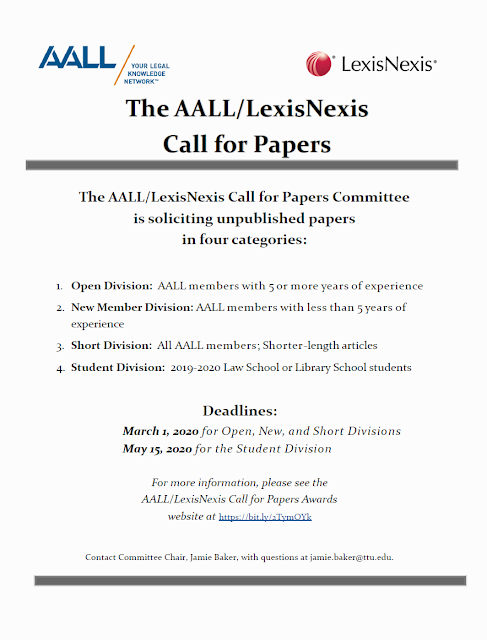A Concerted Effort to Collect Law Library Statistics
We've caught wind that the ABA Standards Review Committee will be proposing to the ABA Council that Section III of the annual questionnaire (dealing with libraries) be eliminated, along with many other parts of the questionnaire not seeking data required by the Standards. This proposal will be considered by the Council at its July meeting for implementation in the 2017 questionnaire. Issues involving the questionnaires are not subject to hearings as are changes to the Standards--they just go directly from the Committee to the Council. The information regarding faculty members (director or teaching) in the library will continue to be collected in other parts of the questionnaire, and there will be a line for total library expenditures with other law school expenditures.
This does not bode well for the compilations of law library statistics that we rely on to work with law school administrators.
As mentioned in the announcement, the annual compilation of library statistics has been continued largely because of librarian interest in the information--they are not included in the Standard 509 reports and a law school would not be subject to interim monitoring for any of the data reported. So, if we want to continue the effort of compiling more detailed library information, it will have to be done by us.
While AALL will certainly be helpful in this endeavor, more libraries may want to look into the ALLStAR Benchmarking Survey.
ALLStAR, or Academic Law Libraries: Statistics, Analytics and Reports, is a new project supported by the Yale Law Library and the NELLCO Law Library Consortium that will enable academic law libraries to systematically gather and analyze a large set of relevant and previously unobtainable data points. Using Counting Opinions' LibPAS as the interface, participating libraries will be able to analyze their own operations, as well as undertake extensive benchmarking against any other participating library or libraries they choose.
Why Benchmark?
This does not bode well for the compilations of law library statistics that we rely on to work with law school administrators.
As mentioned in the announcement, the annual compilation of library statistics has been continued largely because of librarian interest in the information--they are not included in the Standard 509 reports and a law school would not be subject to interim monitoring for any of the data reported. So, if we want to continue the effort of compiling more detailed library information, it will have to be done by us.
While AALL will certainly be helpful in this endeavor, more libraries may want to look into the ALLStAR Benchmarking Survey.
ALLStAR, or Academic Law Libraries: Statistics, Analytics and Reports, is a new project supported by the Yale Law Library and the NELLCO Law Library Consortium that will enable academic law libraries to systematically gather and analyze a large set of relevant and previously unobtainable data points. Using Counting Opinions' LibPAS as the interface, participating libraries will be able to analyze their own operations, as well as undertake extensive benchmarking against any other participating library or libraries they choose.
Why Benchmark?
- To identify, understand, and quantify our strengths and weaknesses
- To understand the drivers of demand on library resources and how they are changing
- To enable you to align internal resource allocation
- To enable you to:
- Justify resources needed
- Motivate staff to consider change
- Plan strategically for the future

While this information will no longer be part of the ABA annual questionnaire, it still behooves law libraries to maintain statistics for benchmarking purposes. ALLStAR may just be the concerted effort that we need to fill this impending gap in our information.


Comments
Post a Comment